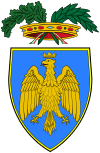Udine
Udine (US: /ˈuːdineɪ/ OO-dee-nay,[3][4] Italian: [ˈuːdine] (![]()
Udine | |
|---|---|
| Comune di Udine | |
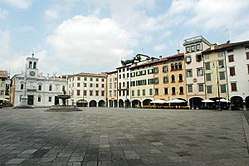 Piazza San Giacomo | |
 Coat of arms | |
Location of Udine 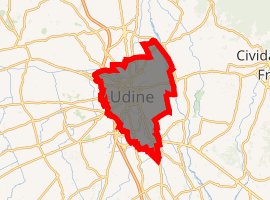
| |
 Udine Location of Udine in Italy 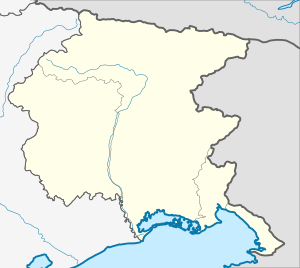 Udine Udine (Friuli-Venezia Giulia) | |
| Coordinates: 46°04′N 13°14′E | |
| Country | Italy |
| Region | Friuli-Venezia Giulia |
| Province | Udine (UD) |
| Frazioni | see list |
| Government | |
| • Mayor | Pietro Fontanini (Lega Nord) |
| Area | |
| • Total | 56 km2 (22 sq mi) |
| Elevation | 113 m (371 ft) |
| Population (31 January 2012)[2] | |
| • Total | 100,514 |
| • Density | 1,800/km2 (4,600/sq mi) |
| Demonym(s) | Udinese |
| Time zone | UTC+1 (CET) |
| • Summer (DST) | UTC+2 (CEST) |
| Postal code | 33100 |
| Dialing code | 0432 |
| Patron saint | Sts. Ermacoras and Fortunatus |
| Saint day | 12 July |
| Website | Official website |
Names and etymology
Udine was first attested in medieval Latin records as Udene in 983 and as Utinum around the year 1000. The origin of the name Udine is unclear. It has been tentatively suggested that the name may be of pre-Roman origin, connected with the Indo-European root *ou̯dh- 'udder' used in a figurative sense to mean 'hill'.[5][6] The Slovene name Videm (with final -m) is a hypercorrection of the local Slovene name Vidan (with final -n), based on settlements named Videm in Slovenia.[6] The Slovene linguist Pavle Merkù characterized the Slovene form Videm as an "idiotic 19th-century hypercorrection."[7]
History
Udine is the historical capital of Friuli. The area has been inhabited since the Neolithic age, and is believed to have been settled by Illyrians.
Based on an old Hungarian legend, Attila (?–453), the leader of the Huns, built a hill there, when besieging Aquileia, because he needed a winter quarters billet: he instructed his soldiers to bring soil in their helmets and shields, because the landscape was too flat, without any hill. He established the town there, and built a square-shape tower.[8]
After the fall of the Western Roman Empire, the area increased in importance after the decline of Aquileia and afterwards of Cividale also. In AD 983 Udine was mentioned for the first time, with the donation of the Utinum castle by emperor Otto II to the Patriarchs of Aquileia, then the main feudal lords of the region. In 1223, with the foundation of the market,[9] the city became finally the most important in the area for economy and trade, and also became the Patriarch's seat.
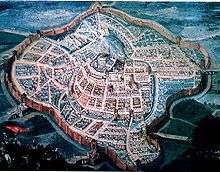
In 1420, it was conquered by the Republic of Venice.[9] In 1511, it was the seat of a short civil war, which was followed by an earthquake and a plague. Udine remained under Venetian control until 1797,[9] being the second largest city in the state. After the short French domination which ensued, it was part of the Austrian-puppet Lombardy-Venetia Kingdom, and was included in the newly formed Kingdom of Italy in 1866.[9]
During World War I, before the defeat in the battle of Caporetto, Udine became the seat of the Italian High Command and was nicknamed "Capitale della Guerra" ("War Capital"). After the battle, it was occupied by the Germans in 1917[10] and Austrians in 1918 until after the Battle of Vittorio Veneto in 1918. After the war it was made capital of a short-lived province (Provincia del Friuli) which included the current provinces of Gorizia, Pordenone and Udine. After September 8, 1943, when Italy surrendered to the Allies in World War II, the city was under direct German administration, which ceased in April 1945.
Geography
Climate
Udine has a humid subtropical climate (Köppen: Cfa). Precipitation is abundant year round with spring and fall being the wettest seasons. The highest temperature recorded was 38.2 °C (101 °F) on July 21, 2006 while the lowest temperature recorded was −18.6 °C (−1 °F) on December 19, 2009.[11]
| Climate data for Udine (1971–2000, extremes 1969–present) | |||||||||||||
|---|---|---|---|---|---|---|---|---|---|---|---|---|---|
| Month | Jan | Feb | Mar | Apr | May | Jun | Jul | Aug | Sep | Oct | Nov | Dec | Year |
| Record high °C (°F) | 18.6 (65.5) |
23.2 (73.8) |
25.6 (78.1) |
29.5 (85.1) |
33.2 (91.8) |
36.2 (97.2) |
38.2 (100.8) |
37.0 (98.6) |
34.4 (93.9) |
29.8 (85.6) |
25.3 (77.5) |
17.4 (63.3) |
38.2 (100.8) |
| Average high °C (°F) | 7.7 (45.9) |
9.8 (49.6) |
13.5 (56.3) |
17.1 (62.8) |
22.3 (72.1) |
25.6 (78.1) |
28.2 (82.8) |
28.4 (83.1) |
24.1 (75.4) |
18.6 (65.5) |
12.6 (54.7) |
8.5 (47.3) |
18.0 (64.4) |
| Daily mean °C (°F) | 3.7 (38.7) |
5.0 (41.0) |
8.4 (47.1) |
12.0 (53.6) |
17.1 (62.8) |
20.3 (68.5) |
22.7 (72.9) |
22.6 (72.7) |
18.7 (65.7) |
13.7 (56.7) |
8.2 (46.8) |
4.5 (40.1) |
13.1 (55.6) |
| Average low °C (°F) | −0.4 (31.3) |
0.3 (32.5) |
3.4 (38.1) |
7.0 (44.6) |
11.8 (53.2) |
15.0 (59.0) |
17.1 (62.8) |
16.9 (62.4) |
13.3 (55.9) |
8.8 (47.8) |
3.7 (38.7) |
0.5 (32.9) |
8.1 (46.6) |
| Record low °C (°F) | −14.6 (5.7) |
−11.6 (11.1) |
−10.0 (14.0) |
−4.8 (23.4) |
1.4 (34.5) |
5.6 (42.1) |
8.2 (46.8) |
6.6 (43.9) |
3.0 (37.4) |
−3.2 (26.2) |
−8.4 (16.9) |
−18.6 (−1.5) |
−18.6 (−1.5) |
| Average precipitation mm (inches) | 74.9 (2.95) |
61.6 (2.43) |
86.2 (3.39) |
119.0 (4.69) |
118.2 (4.65) |
137.9 (5.43) |
81.2 (3.20) |
79.1 (3.11) |
124.3 (4.89) |
134.5 (5.30) |
108.1 (4.26) |
85.9 (3.38) |
1,210.9 (47.67) |
| Average precipitation days (≥ 1.0 mm) | 6.2 | 5.2 | 7.6 | 9.8 | 10.8 | 10.5 | 7.8 | 7.2 | 7.3 | 8.3 | 7.2 | 6.7 | 94.6 |
| Source: Servizio Meteorologico[11][12] | |||||||||||||
Demographics
In 2007, there were 97,880 people residing in Udine itself (whereas the greater area has a population double its size), located in the province of Udine, Friuli Venezia Giulia, of whom 46.9% were male and 53.1% were female. Minors (children ages 18 and younger) totalled 14.36 percent of the population compared to pensioners who number 24.27 percent. This compares with the Italian average of 18.06 percent (minors) and 19.94 percent (pensioners). The average age of Udine residents is 47 compared to the Italian average of 42. In the five years between 2002 and 2007, the population of Udine grew by 1.48 percent, while Italy as a whole grew by 3.56 percent. The current birth rate of Udine is 9.13 births per 1,000 inhabitants compared to the Italian average of 9.45 births.
The nearby area close to the border has a Slovene population estimated at about 2,000.[9] A 1475 document mentions Slovene as the language of the "lower class" in the town, and the Udine Manuscript of 1458 contains Slovene vocabulary.[9] Alasia da Sommaripa's Italian-Slovenian dictionary was printed in Udine in 1607.[9] However, the Slovenian minority is not officially recognized by the Municipality and the Slovenian language is not taught in any city state educational institution, nor in neighboring municipalities. Udine, on the other hand, is one of the municipalities in Friuli where the Friulian language is taught.
As of 2006, 90.90% of the population was of Italian descent. The largest immigrant group came from other European nations (particularly those from Albania and Romania): 5.37%, followed by sub-saharan Africa (mostly from Ghana): 1.65%, and North African: 0.77%.
Government
Main sights
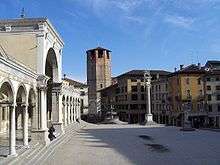
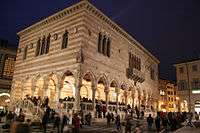
The old residence of the patriarchs of Aquileia, the palazzo Patriarcale, was erected by Giovanni Fontana in 1517 in place of the older one destroyed by an earthquake in 1511. Under the Austrians it was used as a prison. In the cathedral archives was formerly preserved a recension of the Visigothic code of laws, called the Breviary of Alaric, in a manuscript known as the Codex Utinensis, which was printed before it was lost.
In the 1550s, Andrea Palladio erected some buildings in Udine. The Oratorio della Purità has 18th-century frescoes by Giambattista Tiepolo and his son Giandomenico.
The church dedicated to St. Mary of the Castle is probably the oldest in Udine, judging from extant fragments dating back to the Lombard era. It lost its parish status in 1263, when it was annexed to the larger parish of Saint'Odorico (now the Cathedral). It has been renovated many times over the centuries: the façade, for example, was entirely rebuilt after the 1511 Idrija earthquake. Its three naves preserve the suggestive atmosphere of silence and contemplation, which is often found in old churches. The Venetian Governor, Tommaso Lippomano, commissioned the Venetian Gothic portico with steps and ramps leading down the hill in 1487.
In the principal square (Piazza della Libertà) stands the town hall (Loggia del Lionello) built in 1448–1457 in the Venetian-Gothic style opposite a clock tower (Torre dell'Orologio) resembling that of the Piazza San Marco at Venice. It was begun in 1448 on a project by Nicolò Lionello, a local goldsmith, and was rebuilt following a fire in 1876. The new design was projected by the architect Andrea Scala.
Opposite the Loggia del Lionello is the Loggia di San Giovanni, a Renaissance structure designed by Bernardino da Morcote. Other noteworthy monuments in the square are the Fountain by Giovanni Carrara, an architect from Bergamo (1542); the Columns bearing the Venetian Lion and the Statue of Justice (1614), the statues of Hercules and Cacus and the Statue of Peace (1819) which was donated to Udine by Emperor Francis I to commemorate the peace Treaty of Campoformido.[13]
The Cathedral of Udine is an imposing edifice whose construction started in 1236, on a Latin cross-shaped plan with three naves and chapels along the sides. The church was consecrated in 1335 as Santa Maria Maggiore. At the beginning of the 18th century a radical transformation project involving both the exterior and the interior was undertaken at the request and expense of the Manin family. The Baroque interior has monumental dimensions and contains many works of art by Tiepolo, Amalteo, and Ludovico Dorigny. On the ground floor of the bell tower (built from 1441 over the ancient baptistry) is a chapel which is completely adorned with frescoes by Vitale da Bologna (1349).
The centre of Udine is dominated by the castle, built by the Venetians from 1517 over a Lombard fortification ruined by an earthquake in 1511. The current Renaissance appearance dates from the intervention of Giovanni da Udine, who finished the works starting from 1547. The castle houses one of the most ancient Parliament Halls of Europe.
Other points of interest
- Orto Botanico Friulano, a botanical garden
- Parco Botanico Friulano "Cormor", a park and botanical garden
Culture
Udine has a university, the University of Udine. The archbishop's palace and the Museo Civico have quite important paintings. The city has a theater, the Teatro Giovanni da Udine.
Important festivals include the wine-and-food September festival, Friuli D.O.C., the national literary prize for non-fiction Premio Friuli Storia and the biggest European festival of popular East Asian cinema, the Far East Film Festival, in April.
Asteroid 33100 Udine was named in honour of the city.
Along with Italian, Friulian is often spoken in Udine, as well as a variant of Venetian (called Venetin) that is however in decline.
Museums
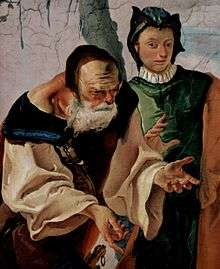
- Civici musei e gallerie di storia e arte (since 1906) with Museo Archeologico, Galleria d'Arte Antica, Galleria dei Disegni e delle Stampa, Museo Friulano della Fotografia, Fototeca e Collezioni Risorgimentali[14]
- Museo di Arte Moderna e Contemporanea
- Museo etnografico del Friuli (Palazzo Giacomelli)
- Gallerie del Progetto
- Museo del Duomo di Udine
- Museo diocesano e gallerie del Tiepolo
Economy
Udine is important for commerce, with several commercial centers in the hinterland. There are also iron and mechanical industries (Danieli and ABS are the most important).
Transport
With 7,600,000 travelling people every year, Udine railway station is the most important station in Friuli-Venezia Giulia. Train services operate to Venice, Treviso, Trieste, Gemona del Friuli, Tarvisio, Cividale del Friuli, Padua, Bologna, Rome, Verona and Milan. International trains operate to Vienna and Munich.
Gallery
Sport
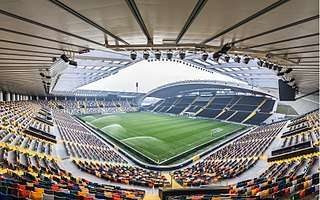
The main football club in the city is Udinese Calcio, founded in 1896, who play in the Serie A (2019–2020 season). Their ground, the Stadio Friuli, was a venue at the 1990 FIFA World Cup.
The local basketball team, APU GSA, played in the second national league, the LegaDue.
Notable people
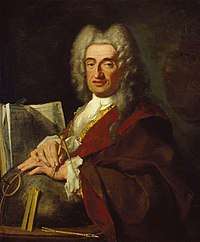
- Luigi De Agostini (born 1961), football player
- Afro Basaldella (1912–1976), painter
- Giuseppe Battiston (born 1968), actor
- Enzo Bearzot, (1927–2010), national football trainer
- Girolamo di Bernardino, 16th-century painter of frescoes
- Bernardino Blaceo, 16th-century painter
- Emanuele Blandamura (born 1979), boxer
- Sebastiano Bombelli (1635-1719), Baroque and Rococò painter
- José Bragato, (1915–2017), cellist and composer
- Carlo Caneva (1845–1922), major general
- Luca Carlevarijs, (1663–1730), painter
- Elena Cecchini (born 1992), cyclist
- Andrea Centazzo (born 1948), drummer and composer
- Bruno Chizzo (1916–1969), football player
- Giovanni da Udine, (1487–1564), painter (Renaissance)
- Raimondo D'Aronco, (1857–1932), architect
- Mario David (1934–2005), football player and coach
- Alfredo Foni (1911–1985), football player and coach
- Fabio Frittelli, (1966–2013), better known by his pseudonym Mo-Do, an Italian musician
- Massimo Giacomini, (born 1939), former football player and sports commentator
- Francesco Janich (1937–2019), football player
- Dalila Di Lazzaro (born 1953), actress and model
- Ernesto Lomasti, (1959–1979), mountaineer
- Guido Macor, (born 1932), retired footballer
- Fabio Masotti (born 1974), cyclist
- Alberto Mazzucato (1813–1877), composer and music teacher
- Tina Modotti (1896–1942), photographer, actress, revolutionary
- Francesco Pavona (1695–1777), Baroque painter
- Daniele Petri (born 1980), Italian darts player
- Nicola Pezzetta (born 1963), artist and architect
- Luigi Pio Tessitori, (1887–1919), indologist, linguist
- Alessandro Piu (born 1996), football player
- Bruno Pizzul, (born 1938), sports journalist and football player
- Bruno Sacco (born 1933), car designer
- Alessia Tuttino (born 1983), football player
- Elena Valentinis (1396–1458), Roman Catholic Blessed professed religious
- Glauco Venier (born 1962), jazz pianist and composer
- Giuseppe Virgili (1935–2016), Italian footballer (striker)
- Alessandro Zanni, (born 1984), rugby union player
International relations
Twin towns – sister cities
Udine is twinned with:[15][16]



.svg.png)



.svg.png)
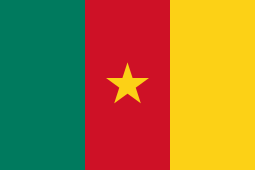
Friendship






References
- "Superficie di Comuni Province e Regioni italiane al 9 ottobre 2011". Istat. Retrieved March 16, 2019.
- "Popolazione Residente al 1° Gennaio 2018". Istat. Retrieved March 16, 2019.
- "Udine". The American Heritage Dictionary of the English Language (5th ed.). Boston: Houghton Mifflin Harcourt. Retrieved August 1, 2019.
- "Udine". Merriam-Webster Dictionary. Retrieved August 1, 2019.
- Pellegrini, Giovan Battista. 1990. Toponomastica italiana: 10000 nomi di città, paesi, frazioni, regioni, contrade, fiumi, monti spiegati nella loro origine e storia. Milan: Hoepli, p. 130.
- Snoj, Marko (2009). Etimološki slovar slovenskih zemljepisnih imen. Ljubljana: Modrijan. p. 454.
- Toporišič, Jože. 2002. "Pavle Merkù o Slovenskem pravopisu 2001." Kras 54/55: 62–64. Reprinted in: Jože Toporišič. 2011. Intervjuji in polemike, pp. 329–333. Ljubljana: Založba ZRC, p. 330.
- Lengyel, Dénes (1972). Régi Magyar mondák. Budapest: Móra Ferenc. ISBN 963-11-2928-4.CS1 maint: ref=harv (link)
- Marušič, Branko. 2000. Videm. Enciklopedija Slovenije, vol. 14. Ljubljana: Mladinska knjiga, pp. 224–225.
- "On This Day – 29 October 1917". firstworldwar.com. Retrieved October 29, 2017.
- "Udine Rivolto: Record mensili dal 1969" (in Italian). Servizio Meteorologico dell'Aeronautica Militare. Retrieved February 23, 2016.
- "Udine/Rivolto (UD)" (PDF). Atlante climatico. Servizio Meteorologico. Retrieved February 23, 2016.
- "Viaggio in Friuli Venezia Giulia | Udine - Piazza Libertà". www.viaggioinfriuliveneziagiulia.it. Retrieved November 24, 2018.
- Un'importante donazione fu quella di monete e reperti archeologici della prima sala al piano terra nell'ala est del Castello, donazione di Augusto de' Brandis, del 1924 (vedi Bergamini, 2002 e provincia.udine.it Archived July 12, 2014, at the Wayback Machine).
- "Gemellaggi e relazioni internazionali". comune.udine.it (in Italian). Udine. Retrieved December 16, 2019.
- "Our Twin Cities". citywindsor.ca. Windsor. Retrieved December 16, 2019.
External links
| Wikimedia Commons has media related to Udine. |
| Wikisource has the text of the 1911 Encyclopædia Britannica article Udine. |
- Udine homepage
- Udine on Italia.it
- Udine, Italy: a cultural guide by Sunday Telegraph







